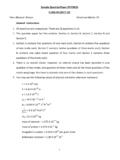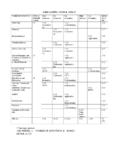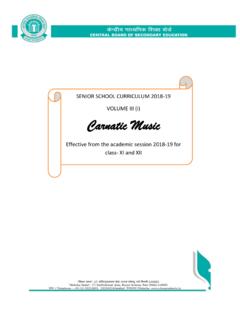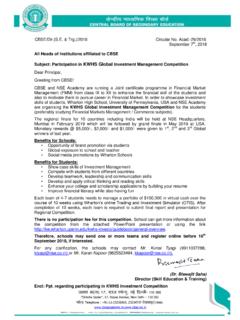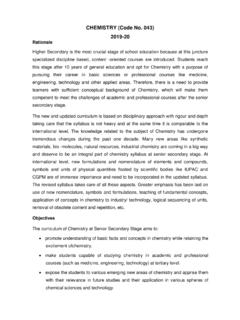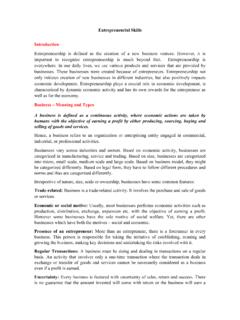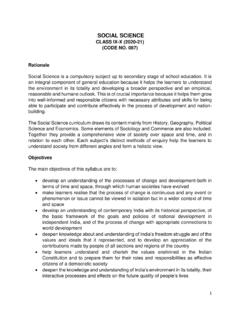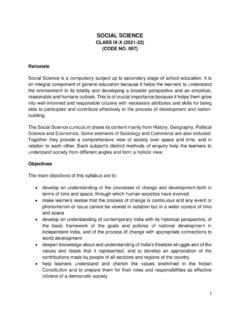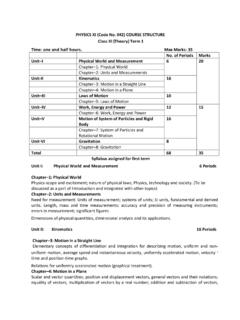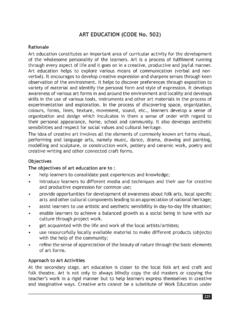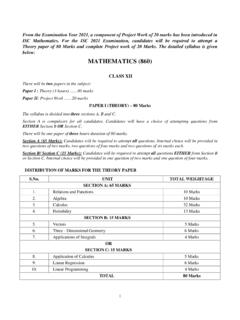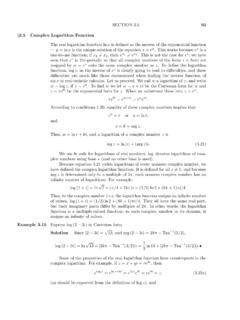Transcription of MATHEMATICS (XI-XII) (Code No. 041) Session 2021-22
1 MATHEMATICS (XI-XII) (Code No. 041) Session 2021-22 The Syllabus in the subject of MATHEMATICS has undergone changes from time to time in accordance with growth of the subject and emerging needs of the society. Senior Secondary stage is a launching stage from where the students go either for higher academic education in MATHEMATICS or for professional courses like Engineering, Physical and Biological science, Commerce or Computer Applications. The present revised syllabus has been designed in accordance with National Curriculum Framework 2005 and as per guidelines given in Focus Group on Teaching of MATHEMATICS 2005 which is to meet the emerging needs of all categories of students.
2 Motivating the topics from real life situations and other subject areas, greater emphasis has been laid on application of various concepts. Objectives The broad objectives of teaching MATHEMATICS at senior school stage intend to help the students: to acquire knowledge and critical understanding, particularly by way of motivation and visualization, of basic concepts, terms, principles, symbols and mastery of underlying processes and skills. to feel the flow of reasons while proving a result or solving a problem. to apply the knowledge and skills acquired to solve problems and wherever possible, by more than one method. to develop positive attitude to think, analyze and articulate logically.
3 To develop interest in the subject by participating in related competitions. to acquaint students with different aspects of MATHEMATICS used in daily life. to develop an interest in students to study MATHEMATICS as a discipline. to develop awareness of the need for national integration, protection of environment, observance of small family norms, removal of social barriers, elimination of gender biases. to develop reverence and respect towards great Mathematicians for their contributions to the field of MATHEMATICS . COURSE STRUCTURE CLASS XI ( 2021-22 ) TERM - I One Paper 90 Minutes Max Marks: 40 No. Units Marks I.
4 Sets and Functions 11 II. Algebra 13 III. Coordinate Geometry 6 IV. Calculus 4 V. Statistics and Probability 6 Total 40 Internal Assessment 10 Total 50 *No chapter-wise weightage. Care to be taken to cover all the chapters. Unit-I: Sets and Functions 1. Sets Sets and their representations. Empty set. Finite and Infinite sets. Equal sets. Subsets. Subsets of a set of real numbers especially intervals (with notations). Power set. Universal set. Venn diagrams. Union and Intersection of sets. 2. Relations & Functions Ordered pairs. Cartesian product of sets. Number of elements in the Cartesian product of two finite sets.
5 Cartesian product of the set of reals with itself ( R x R only).Definition of relation, pictorial diagrams, domain, co-domain and range of a relation. Function as a special type of relation. Pictorial representation of a function, domain, co-domain and range of a function. Real valued functions, domain and range of these functions, constant, identity, polynomial, rational, modulus, signum, exponential , logarithmic and greatest integer functions, with their graphs. Unit-II: Algebra 1. Complex Numbers and Quadratic Equations Need for complex numbers, especially 1, to be motivated by inability to solve some of the quardratic equations.
6 Algebraic properties of complex numbers. Argand plane. Statement of Fundamental Theorem of Algebra, solution of quadratic equations (with real coefficients) in the complex number system. 2. Sequence and Series Sequence and Series. Arithmetic Progression (A. P.). Arithmetic Mean ( ) Geometric Progression ( ), general term of a , sum of n terms of a , infinite and its sum, geometric mean ( ), relation between and Unit-III: Coordinate Geometry 1. Straight Lines Brief recall of two dimensional geometry from earlier classes. Slope of a line and angle between two lines. Various forms of equations of a line: parallel to axis, point -slope form, slope-intercept form, two-point form, intercept form and normal form.
7 General equation of a line. Distance of a point from a line. Unit-IV: Calculus 1. Limits Intuitive idea of limit. Limits of polynomials and rational functions trigonometric, exponential and logarithmic functions Unit-V: Statistics and Probability 1. Statistics Measures of Dispersion: Range, mean deviation, variance and standard deviation of ungrouped/grouped data. Note: For activities NCERT Lab Manual may be referred INTERNAL ASSESSMENT 10 MARKS Periodic Test 5 Marks MATHEMATICS Activities: Activity file record +Term end assessment of one activity & Viva 5 Marks TERM - II One Paper Max Marks: 40 No.
8 Units Marks I. Sets and Functions (Cont.) 8 II. Algebra (Cont.) 11 III. Coordinate Geometry (Cont.) 9 IV. Calculus (Cont.) 6 V. Statistics and Probability (Cont.) 6 Total 40 Internal Assessment 10 Total 50 Unit-I: Sets and Functions 1. Trigonometric Functions Positive and negative angles. Measuring angles in radians and in degrees and conversion from one measure to another. Definition of trigonometric functions with the help of unit circle. Truth of the identity sin2x + cos2x = 1, for all x. Signs of trigonometric functions. Domain and range of trigonometric functions and their graphs.
9 Expressing sin (x y) and cos (x y) in terms of sinx, siny, cosx & cosy and their simple applications. Deducing identities like the following: tan(x y)=tanx tany1 tanxtany ,cot(x y)=cotxcoty 1coty cotx sin sin =2sin12( )cos12( ) cos +cos =2cos12( + )cos12( ) = 2 12( + ) 12( ) Identities related to sin2x, cos2x, tan2 x, sin3x, cos3x and tan3x. Unit-II: Algebra 1. Linear Inequalities Linear inequalities. Algebraic solutions of linear inequalities in one variable and their representation on the number line. Graphical solution of linear inequalities in two variables. Graphical method of finding a solution of system of linear inequalities in two variables.
10 2. Permutations and Combinations Fundamental principle of counting. Factorial n. (n!) Permutations and combinations, formula for nPr and nCr, simple applications. Unit-III: Coordinate Geometry 1. Conic Sections Sections of a cone: circles, ellipse, parabola, hyperbola. Standard equations and simple properties of parabola, ellipse and hyperbola. Standard equation of a circle. 2. Introduction to Three-dimensional Geometry Coordinate axes and coordinate planes in three dimensions. Coordinates of a point. Distance between two points and section formula. Unit-IV: Calculus 1. derivatives Derivative introduced as rate of change both as that of distance function and geometrically.
